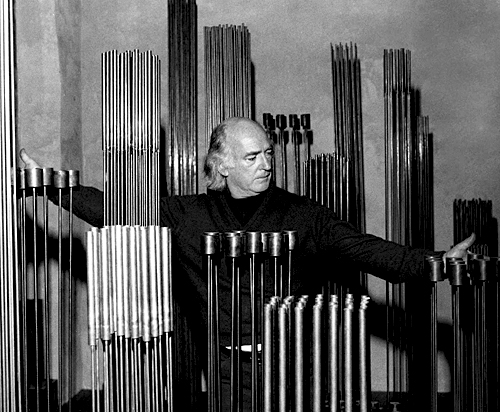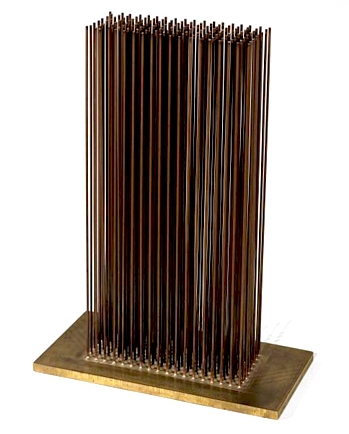Harry Bertoia’s Sound Sculptures
A new exhibit at the Allentown Art Museum offers viewers an inside look at sound sculpture works of Harry Bertoia’s unique metal sound sculptures. Although most are familiar with Bertoia’s iconic furniture designs, these majestic auditory works of art impressively combine both form and function, giving viewers a visceral experience through these beautifully crafted metal structures.
 Harry Bertoia Metal Sound Sculpture.
Harry Bertoia Metal Sound Sculpture.Photograph courtesy of 2017 Estate of Harry Bertoia / Artists Rights Society (ARS), New York
Val Bertoia, Harry’s son, estimates that his father created more then 1200 musical sculptures. Each is unique in its experimentation with materials and other variables that affect sound, with different configurations and a varying diameter of rods. The sculptures were all created at Bertoia’s studio in Bally, PA.
The exhibit, Reverberations, on view through Jan. 7, offers one of the most comprehensive glimpses into Bertoia’s work with sound, giving viewers a chance to experience these magnificent sculptures up close. Visitors are allowed to play the sculptures and experience the sound sculptures firsthand, as long as they are accompanied by a docent or security guard.
The Museum coordinated the loan of Bertoia works for the Symphony collaboration and Reverberations from area lenders including Muhlenberg College, the City of Bethlehem, BertoiaStudio, Ursinus College, and private collectors Lyne Raymond and George Ross, Reverberations also includes three Bertoia sculptures and two Bertoia prints from the Museum’s collection.
 Harry Bertoia, 1972 in his studio in Bally, PA.
Harry Bertoia, 1972 in his studio in Bally, PA.Photograph courtesy of 2017 Estate of Harry Bertoia.
The exhibit was created as a collaboration with the Allentown Symphony Orchestra, who commissioned Dr. Douglas Ovens to compose a work for Bertoia sound sculptures and orchestra.
“Many of the sculptures in this exhibition were chosen by Doug for their auditory qualities,” says exhibition curator, Claire McRee. “To present these sculptures in Reverberations, I added works that further illuminate Bertoia’s interest in sound and art, including a singing bars sculpture and two prints.
I like that the selection of works in this exhibition is rooted in a focus on sound – not just an interest in form as you’d expect in most art exhibitions. This relationship between sound and form is central to Bertoia’s tonal sculptures, which are as much about listening as seeing.”
Although he is most well known for designing some of the most iconic chairs in the world, Bertoia was a master printmaker and sculpture, and loves exploring the depths of sound and space within his multi-media art.
 Sounding Piece, ca. 1974, beryllium copper, brass plate.
Sounding Piece, ca. 1974, beryllium copper, brass plate. Photograph courtesy of 2017 Estate of Harry Bertoia.
“In his furniture design, as well as his printmaking, Bertoia created thoughtful relationships between positive and negative space. In these mediums, he also made use of organic shapes that evoked nature (for instance, the curve of a leaf or the scatter of stars in a galaxy). Bertoia carried these themes into his sculptures: he believed that the empty space in a sculpture was just as crucial as its physical elements. For many, his sound sculptures evoke natural sounds (for instance, wind in the trees or ocean waves) and natural forms (ex. grass or cattails).”
In the 1950s, Bertoia began pursuing sculpture full-time in the 1950s, and a seredipitious moment changed his path forever.
“Bertoia was inspired to create sound sculpture when he accidentally broke a metal rod he was working with,” explains McRee. “When the piece hit another rod and created sound, he grew curious about what the possibilities of this could be. Beginning in 1960 and continuing through the end of his life in 1978, sound sculptures became his primary focus. In 1968-69, he even renovated his barn to become a recording studio and concert hall that housed over 75 sculptures.
Although sound sculpture had been seen in the art world, Bertoia was the first to fine tuned the sonambient model of sculpture, and was the first artist to thoroughly explore the possibility of sculptures that make sound.
“He was very innovative in that regard,” says McRee. “He didn’t coin the phrase ‘sound sculpture’ to my knowledge. However, he did create the word ‘sonambient’ to describe the environment created when his sculptures are played – both the visual and auditory experience created by his work.
 Harry Bertoia in 1970 with his work.
Harry Bertoia in 1970 with his work.Photograph courtesy of 2017 Estate of Harry Bertoia.
Although Bertoia worked in a variety of metals, he favored beryllium copper for sound sculptures because of its sounding properties. Many of his tonal sculptures use a brass base plate to support the beryllium copper rods, including two works in our collection: Sounding Piece and Tonal.
“He also experimented with a variety of other metals, including brass, bronze, copper, aluminum, and industrial alloys like Monel and Inconel. Differing metals offered different timbres – for instance, in our exhibition the sculptures with beryllium copper rods have a rich ringing sound, while those with bronze ones are a bit less resonant and more clanging,” she says. “Bertoia was constantly varying materials and form in his sculpture with the goal of creating an endless variety of sounds – he talks about his process as bordering on that of a scientist.”
Resources:
Also in this Issue:
- Harry Bertoia’s Sound Sculptures
- The Continuing Legacy of Sustainable Jewelry
- Maine Copper Studio
- Abraham Lincoln, Reimagined Through Pennies
